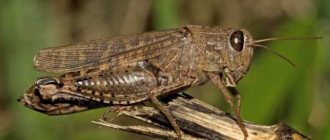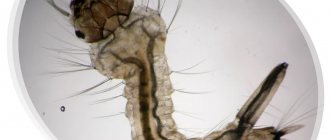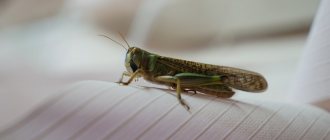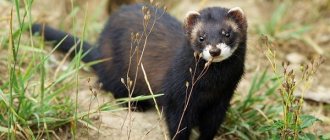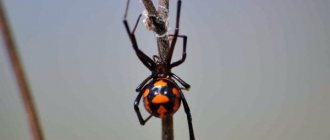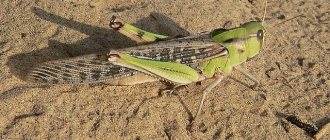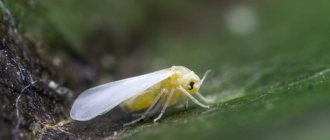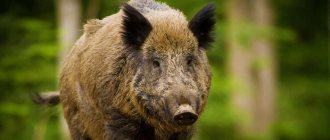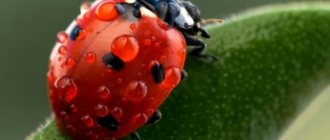The locust is a fairly large insect from the class of Orthoptera. For a long time, it has represented the main threat to cultivated crops.
Descriptions of locusts can be found in such ancient writings as the Bible, the works of the authors of ancient Egypt, the Koran, and so on.
Locust coloring
The color of locusts depends on the environment in which they live. Even individuals of the same offspring can differ in color. Ways of living alone have brighter colors.
If such an individual enters the herd, it acquires a color characteristic of the entire herd. Also, pronounced sexual characteristics disappear in the herd.
Appearance
The locust insect, also called locust, belongs to the family of true locusts, order Orthoptera. The name comes from Turkic languages, which means “yellow”. But the color of the locust can vary from grayish to olive-brown depending on the habitat and age of the locust.
Interesting!
The locust's coloration camouflages the insect. It differs even among close relatives and depends not only on the species, but also on the environment, nutrition, and climate humidity.
The locust has a body length from 1 to 20 cm. The head is large with a powerful jaw apparatus and large eyes on the sides. The lower wings are a transparent shade of light green and are covered with hard wing covers. The size of females is larger than that of males. Female locusts have a short, sharp ovipositor. Just like a male locust makes sounds by rubbing special notches located on the thighs of the hind legs against the thickening on the elytra.
Distinctive features of locusts
Let's look at how to distinguish a locust from a grasshopper:
- The locust's antennae are much shorter than those of the grasshopper;
- the locust's legs are also shorter than those of the grasshopper;
- locusts are active during the day, and grasshoppers are active at night;
- grasshoppers are harmless, but locusts harm agricultural crops;
- grasshoppers are predatory insects, and locusts feed on plant foods.
Nutrition
Many people are interested in whether locusts eat insects or not. We hasten to assure you that she is a purely herbivorous creature and her diet includes only grass and dew (water that accumulates on plant stems).
Locusts, leading a solitary lifestyle, are not a pest for meadows or fields that are sown with valuable crops. She eats almost all the grass, but in such quantities that it cannot cause serious damage to the breed and agriculture.
Over the course of her entire rather long and fruitful life, she can eat about three hundred and fifty grams of green food consisting of any plants.
But let’s not forget that this species can quickly group into flocks of billions of individuals, which can cause irreparable harm to an entire city or region.
In a few minutes, these pests gnaw out the entire living grass community to the base of the roots and immediately leave this place, thereby moving to new places for further feasting.
The benefits and harms of locusts
In many countries, locusts are eaten.
Swarms of locusts are a dangerous pest of all plants. After the invasion of a swarm of locusts, nothing remains of vegetation. Adult insects eat all ground green spaces, and the larvae destroy plant roots.
Types of insects
There are a huge number of varieties of locusts. It is impossible to list them all. Some of them include:
Types of locusts
- Moroccan (Dociostaurus maroccanus). Size up to 2 centimeters. Color – reddish-brown with small dark spots. It has a fancy pattern on the back in the form of a light cross. The small size of locusts does not protect crops from total destruction when a whole swarm swoops in. The damage to the land is colossal. For living, locusts have chosen Africa, Central Asia, Egypt, Libya, Algeria, and Morocco. Can be found in European countries.
- Desert. (Schistocerca gregaria). Locusts are distinguished by their large size. The length of the dirty yellow body of the locust can reach 8 cm. The brown wings have a large number of veins. They live in tropical and subtropical countries.
- Migratory. (Locusta migratoria). It is also called Asian. The body has a length of 3.5 to 6 cm. The color is green, brown, gray and yellow. The colorless wings have a smoky tint. Black veins are visible on them. The locusts chose Asian, European, and African countries to live in. This species can be found in southern and Siberian Russian cities, in the Caucasus, and Kazakhstan.
- Italian. (Calliptamus italicus). The peculiarity of the locust is its small body size, its wings are powerful and well developed. Color shades – red, brick, brown, brown, faint pink tones. Longitudinal light stripes and spots are visible on the wings. Habitat: Asia, Mediterranean.
Types of locusts - Egyptian. (Anacridium aegyptium). The female locust is distinguished by its large size. In males they are almost 1.5-2 times smaller. This species chose European countries as its place of residence. Color shades are discreet: gray, light brown, greenish-olive. A characteristic feature of the Egyptian locust is the presence of white and black stripes on the eyes. Representatives of this species are often found in the East, Europe, and northern Africa.
- Rainbow. (Phymateus saxosus). Very poisonous, brightly colored locusts live in Madagascar. The length of its beautiful body, iridescent with all the colors of the rainbow, is about 7 cm. It chooses the leaves of various trees as a shelter, including milkweed, the juice of which is poisonous.
- Siberian. (Gomphocerus sibiricus). A distinctive feature is the small size of the body (up to 2.5 cm). Color brown-brown, olive, gray-green. Widely settled in the regions of the Caucasus Mountains and settlements of Central Asia. Can be found in China, Kazakhstan. It causes significant damage to grain and hay meadows.
- Blue-winged. (Oedipoda caerulescens). The locust is very beautiful, its body size is small (up to 3 cm). The graceful wings are distinguished by a beautiful rich blue color, but at the base it becomes much paler, almost completely losing its color. Their surface is decorated with a beautiful pattern consisting of thin black stripes. The locust settled in the steppes and forest-steppes of European and Asian settlements; it can be found in the Caucasus, western Siberia, and Chinese lands.
Interesting!
There can be about a billion individuals in a swarm of locusts, and the area occupied by it is more than 1 thousand sq.m. The creaking sounds produced by the friction of the wings are similar to thunder.
Ways to fight
If there are not many pests, mechanical cleaning can be used. It is necessary to collect and destroy the larvae in the soil; this is effective only in the early stages.
Digging. It does not always bring results, since it is not possible to remove all the larvae. It is more effective when introducing chemicals to destroy egg laying.
Burning out. In this way you can get rid of clutches of eggs that are shallow in the soil. To increase the depth of heating, the soil surface is covered with straw or peat. To increase the effect, the soil is dug up so that the remaining larvae die during the winter.
Chemical treatment. In specialized stores you can purchase special compounds suitable for locusts. Treatment is carried out in early spring before sowing, since chemical treatment negatively affects the quality of grown products.
Locusts are quite resistant to chemicals, so the plants they feed on are treated. But even the most powerful poisons cannot always get rid of pest infestations.
Timely preventive and protective actions will help save your harvest.
Battle with locusts
It was possible to curb the hordes only by studying the biology of these insects. It turned out that locusts are most vulnerable at the stage of eggs and nymphs. The egg capsules are easily destroyed by plowing the soil, and the nymphs are killed with insecticides or infected with the parasitic fungus Metarhizium. The latter method is especially good, since it is completely safe for the environment, and the reproduction of the fungus in the locust population can be maintained in subsequent generations without human help.
The example of Ukraine is very indicative, where in past centuries locusts were a common insect in the south of the country. It multiplied in reed beds in the Dnieper delta, from where it made devastating raids on the agricultural central regions, sometimes reaching Poland and Lithuania. After the plowing of virgin steppes and the introduction of crop rotation, many eggs began to die during cultivation, and now locusts are rare here.
An even more impressive example is the Rocky Mountain locust (Melanoplus spretus) . This is the only native species of locust in North America, whose breeding grounds were located at the foot of the Rocky Mountains, and from where it raided the lowland states of Colorado, Nebraska, Kansas, Missouri and Minnesota. American farmers were unable to defeat these hordes until the foothills were plowed, as a result of which these locusts... became extinct!
However, this is the only type of locust that has suffered such a fate - all the others are quite prosperous and numerous. Outside of agricultural areas, these insects play a significant role in ecosystems, as they serve as food for many species of birds and animals: guinea fowl, partridges, small falcons, kites, secretary birds, ravens, crows, bustards, meerkats, wild pigs, warthogs. There have often been cases of locusts being eaten by herbivorous ungulates, but researchers differ in their assessment of this phenomenon. Some say that wild antelopes and livestock readily take advantage of such random feeding, while others testify that livestock deaths have been reported after eating locusts.
Photo of locusts
Interesting Facts
- In some countries in Southeast Asia, locusts are a delicacy. Tourists specially reserve seats in restaurants to taste the magnificent masterpieces of exotic dishes that local chefs bring to life.
- At the epicenter of an insect infestation, one can observe and feel the frightening sound noise that these pests make.
- Gathered in groups of many billions, they can destroy crops, crops and steppe meadows in just a few minutes.
- They are distributed throughout the globe except the North Pole.
REPRODUCTION
Mating of locusts can last up to several hours. Almost immediately after mating, the female lays her eggs, usually burying them in the ground. The female's ovipositor is very elastic and can almost double in length. This allows her to lay eggs deep enough into the ground. Each portion of eggs is enveloped in a special foamy liquid, which, when solidified, forms a kind of capsule. The time required for embryo development depends on temperature and climate. Development of the embryos begins immediately after the female lays her eggs. In species living in regions with cold climates, the development of embryos lasts longer, until the onset of cold weather. Then it stops and resumes only in the spring, when warming comes. In warm countries, worm-like larvae hatch after a short time. After the first molt, they become similar to adults, they just do not have formed wings. After this, the larva molts another 4-5 times. Each time its size increases, and at the same time the antennae and wing rudiments gradually lengthen.
Protection measures
To prevent and control locusts, the following measures are taken:
- To destroy the egg capsules of migratory locusts, deep plowing is used.
- To reduce the number of Asian locusts and reduce places suitable for laying eggs, a method is used to drain and further use the floodplains of rivers and lakes for growing crops.
- For chemical treatment of crops of various grain crops, in order to destroy the larvae, they are sprayed with pesticides: Karbofos, Fufan, Sumition, Sherpa; pastures and haylands are treated with the following preparations: Decis Extra, Fastak, Fury.
Omnivorous
There is an opinion that locusts can eat, or rather, devour everything that comes their way. At first they destroy shoots and any vegetation. If they run out, and this happens all the time, they are quite capable of eating their fellow insects or other insects.
Many people believe that locusts are attracted exclusively to the color green. But in fact, these pests are absolutely omnivorous, and the color of plants or insects does not matter at all.
